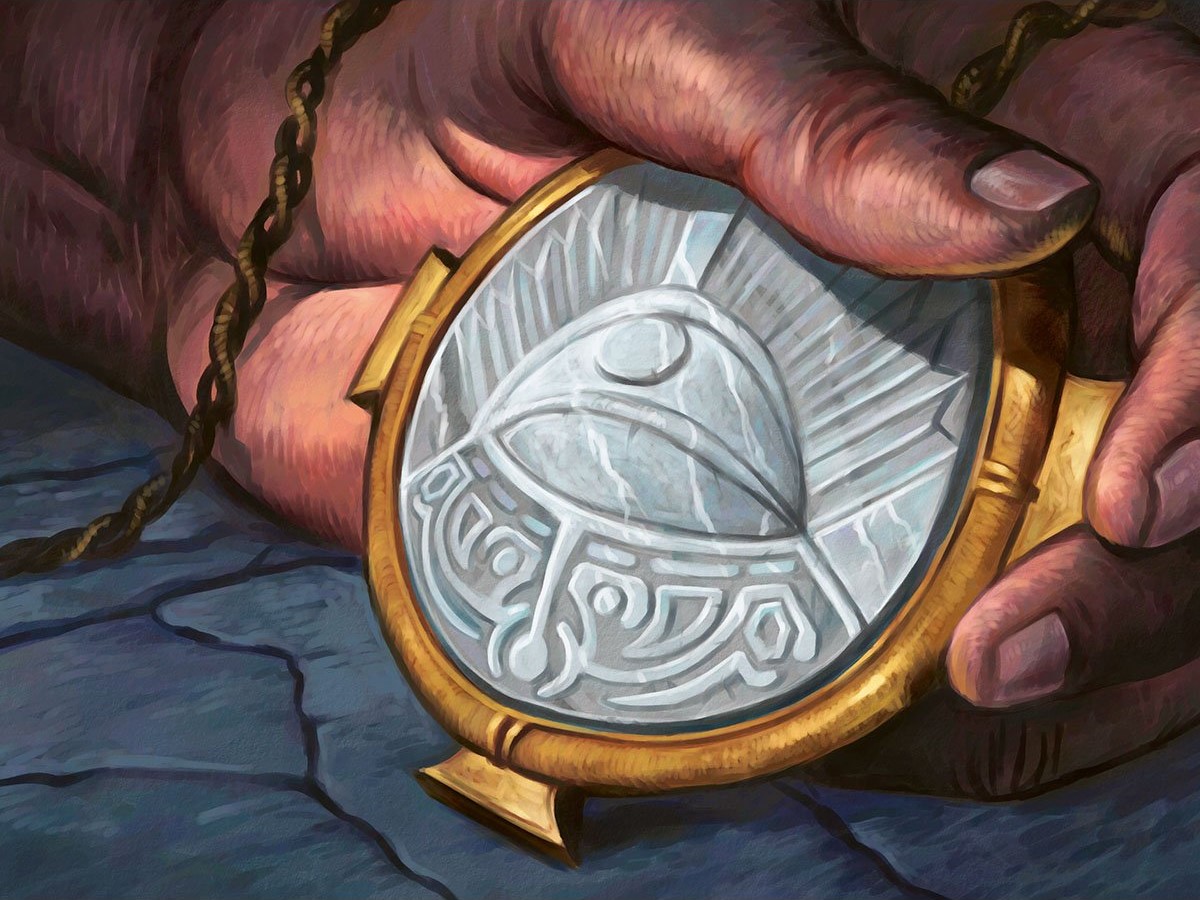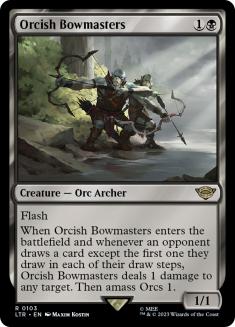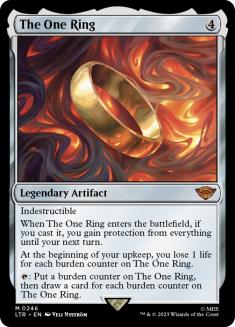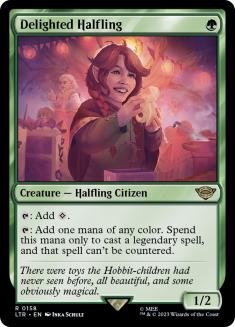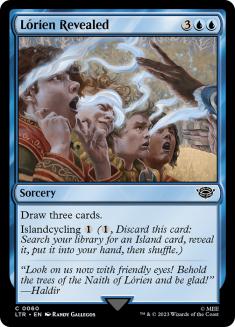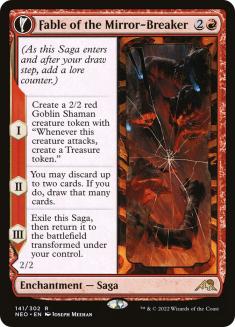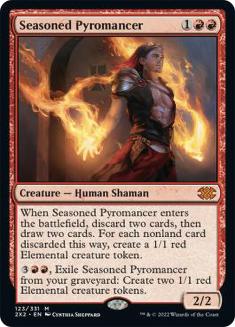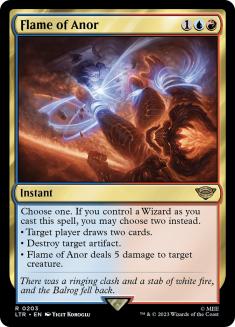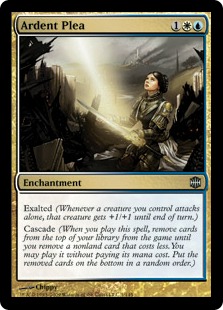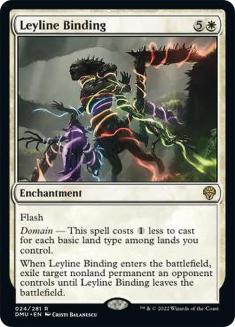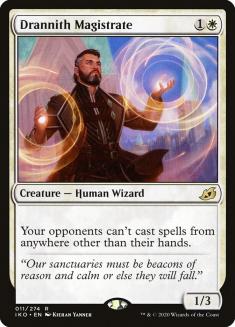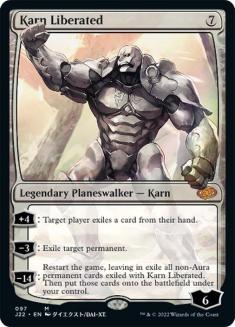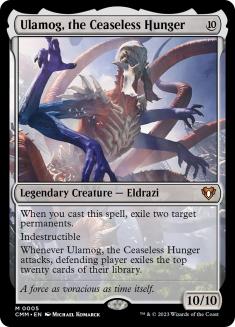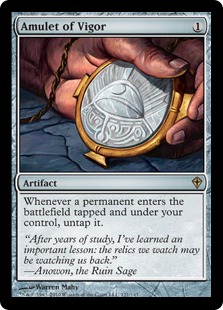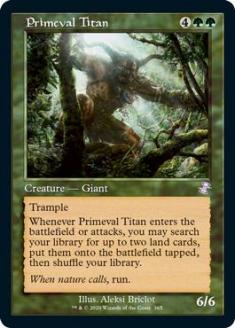I returned from Pro Tour March of the Machine reeling from my awful performance and keen for a shot at redemption that I didn’t expect any time soon. My final loss that weekend was especially painful because I wanted that shot right here at Pro Tour The Lord of the Rings, in my favourite format in an amazing destination.
With my Top 8 at Toronto’s Regional Championship in June, I earned that shot and set my sights on Modern and Limited for the Pro Tour. When that day finally came, I quickly found myself 0-2 in the first draft and on the brink of a 0-3 that would have shattered my hopes for this tournament and my self-image as someone who could compete at that level.
After a miraculous comeback in that final round, I rattled off a win streak that seemed sure to land me in 9th, my tiebreakers fatally wounded from that poor start. I knew that was the likely outcome and made my peace with it. Ninth was still a great finish that would give me a slot at the World Championships in a few weeks and invites for a full year of Pro Tours, as well as a nice payday and some confidence that I deserved to be there. The careers of Pro Tour mainstays from Brad Nelson and Reid Duke to Ari Lax and Javier Dominguez all took off with a ninth place that felt unfortunate at the time but was a precursor of great success – I knew I wasn’t in their company yet, but that thought was a nice consolation at least.
A Twist in the Tale
As I searched for closure in this result, I learned my weekend wasn’t over yet. In one final bizarre twist, the win-and-in match between Alex Hayne and Kazune Kosaka ended in an inconclusive, unintentional draw that freed up a slot in the Top 8. My 9th turned into 8th, and suddenly I found myself with my arm around Kai Budde in a Pro Tour Top 8 photo!
When a friend got me into Magic almost twenty years ago, I spent many lazy afternoons devouring every Pro Tour report I could find in the archives here on Star City Games. I wish I could tell that much younger me that one day he would be writing his own Pro Tour Top 8 report.
Personal Odyssey
Back then, tournament reports were as much about the writer’s personal odyssey as anything else – travel mishaps, team drama, and after-hours hijinks might take up as many column inches as the matches of Magic. For the author, these moments make those memories vivid long after the rounds and cards have all blurred together. For an audience focused on their impending chance to climb up from a lower rung, this could be a motivating glimpse of a shared goal – or it could fall flat altogether. As Magic content moved towards a sharper focus on immediate relevance and bang for your buck, the old-school tournament report became an endangered species that might appear as an occasional treat from a generous editor.
It’s no surprise that the tournament reports mentioned most fondly – or still mentioned at all – are those that make the author and their world come to life, rather than the most detailed dissections of Theros Block Constructed. Those at the top of that game too can weave the strategy and stories in a way that feels seamless. I wish I could flit from my memories of floating in a pool in the mountains with finalist Christian Calcano, chatting about life and Magic – just days before those would transform for both of us – to the ins and outs of current Modern, but the truth is that I don’t fully know what this finish will mean for me or to me yet. Now that I get to hang around that stage for a while, I hope I can get more results like this and more chances to reflect on what that means.
Until then, let’s talk about Magic!
Modern Moments
This Pro Tour marked the first appearance of Modern on Magic’s biggest stage in four years. After the earthquakes of the Eldraine era and the transformation wrought by Modern Horizons 2, Modern had reached a state of relative stability. The eventual bannings of Hogaak, Arisen Necropolis and Arcum’s Astrolabe tarnished the reputation of the original Modern Horizons, and the clean record of Modern Horizons 2 in that regard was an impressive achievement. Cards like the Evoke Elementals; Urza’s Saga; and Ragavan, Nimble Pilferer all warped the format in their own way, but somehow held each other in an unlikely balance.
Behind this lurked a difficult question – what if this peace was only possible because nobody cared enough to break it? The attention of professional players was always elsewhere, and some pros expressed an active disdain for the format. The best minds in the game finally having a reason to focus on Modern would expose any cracks in its foundations.
The Lord of the Rings: Tales of Middle-earth added another late wild card. This straight-to-Modern set didn’t have the depth of a Modern Horizons set, but its star players promised to be just as powerful. In a controversial but certainly flavourful turn of events, The One Ring instantly became a format-defining card that forced every deck to adapt or die. Any deck that was fundamentally weak to The One Ring was off the table; using it well or being able to ignore it was the best argument a deck could make for itself.
Results
There’s a sense of danger and excitement around every Modern Pro Tour – will there be some obscure, broken deck that emerges to take the tournament by storm? Amulet Bloom struck gold for Justin Cohen and Sam Black at Pro Tour Fate Reforged; before his recent retirement as our resident control enthusiast, Shaheen Soorani was one of the earliest adopters of Krark-Clan Ironworks.
The story of this tournament was just the opposite – the teams who made smart updates to proven decks reaped the rewards.
Evoke
Creatures (21)
- 1 Kroxa, Titan of Death's Hunger
- 4 Grief
- 4 Ragavan, Nimble Pilferer
- 4 Dauthi Voidwalker
- 4 Fury
- 4 Orcish Bowmasters
Lands (20)
Spells (19)

Winner Jake Beardsley was the only player on Rakdos Evoke (or Rakdos Midrange) in the Top 8, but it put up an impressive win rate despite being the most popular deck, showing why it was a smart choice for so many. Some adventurous takes on this shell were floating around on Magic Online (MTGO), including a list that paired Persist with landcyclers like Troll of Khazad-Dum and Oliphaunt as ‘lands’ that pitch to Grief and Fury, but the proven formula won the day here.
The most contentious choice in Jake’s list is Fable of the Mirror-Breaker replacing Seasoned Pyromancer in the maindeck. Both cards are excellent in this shell, and in midrange slugfests, you want as many copies of both as you can support, but one has to take priority. Experience in other formats suggests Fable would be the default, but Seasoned Pyromancer is uniquely well-suited to Rakdos Evoke, which empties its hand quickly (or is stuck with conditional cards that it would love to trade in for a new card and a body) and wants additional targets for Feign Death.
The biggest reason for the switch is the new card that helped Rakdos Evoke thrive while so many other top decks were pushed out. Orcish Bowmasters is devastating against Seasoned Pyromancer, and this matters a lot when the Rakdos mirror is the most important matchup in the format.
Rhinos
Creatures (9)
Lands (21)
Spells (30)
- 4 Violent Outburst
- 2 Dismember
- 4 Fire
- 4 Dead
- 4 Force of Negation
- 4 Crashing Footfalls
- 4 Mystical Dispute
- 4 Lorien Revealed
Sideboard

Living End was the obvious beneficiary of the Lord of the Rings landcyclers, but Temur Rhinos / Crashcade, powered by Lorien Revealed, flew the flag for Violent Outburst on Sunday. Consensus had Crashcade as one of the best foils to Rakdos Evoke, and Lorien Revealed padding your blue card count encourages maindeck Subtlety to improve that matchup even further. Dismember offers cheap interaction under cascade’s mana curve restriction, and it deals with most of the creatures you care about these days.
Flame of Anor flew under the radar at first. Expensive modal spells pop up in Crashcade (fan favourite Archmage’s Charm was a staple for a while), but Flame of Anor covers several important bases at once. Chalice of the Void was everywhere in Barcelona, and you need some answers, but not narrow Shatter effects that don’t hit other cards in their deck. The removal mode benefits from the same creature sizing dynamics as Dismember, and having good colours for both blue pitch spells and Fury is relevant too.
The Inspiration mode helps, too. Crashcade wants to mulligan most hands without an early cascade spell or with the wrong interaction for the matchup, so starting with six or five cards is common. The pitch spell package lets you trade card quantity for efficiency, justifying what would otherwise be a fatal mana curve restriction for cascade. Without a way to see extra cards, you run out of raw resources quickly. A clunky draw spell is actually a blessing in that context.
Four-Color Crashcade picks up Ardent Plea for redundancy on Cascade effects; Leyline Binding as a flexible removal spell that beats anti-Cascade measures like Chalice of the Void and Teferi, Time Raveler; and a bold sideboard plan with Drannith Magistrate replacing Crashing Footfalls for cascade mirrors.
Tron
Creatures (5)
Planeswalkers (5)
Lands (18)
Spells (32)

Another Modern Pro Tour in Barcelona meant another fantastic weekend for Mono-Green Tron. Tron was on the rise again even before this Hobbit-themed revolution hit the format, but it gained more from The One Ring than any other deck. Ring is a high-impact play that you can cast without Tron or alongside another spell when your deck is firing on all cylinders. Beating cards like Blood Moon is easier than ever when your big hitters start at four mana rather than seven. Talisman of Resilience is a nod to this. Turn 2 Talisman into Turn 3 Ring isn’t the traditional Tron nut draw, but it’s still impressive.
Tron also gets to prey on opposing Rings, disabling them with Karn, the Great Creator or going over the top with Karn Liberated and Ulamog, the Ceaseless Hunger. Drawing cards is useless if none of them disrupt Tron’s mana engine effectively and Tron’s big plays can erase your development. Control decks that didn’t respect Tron enough found themselves helpless against a popular deck that was everywhere in the winners’ metagame.
The Team Handshake list that put Simon Nielsen and Javier Dominguez in back-to-back Pro Tour Top 8s tries to keep Tron’s explosive potential while raising the floor on the deck’s performance. Urza’s Saga is a potent threat to find with your land searchers that also gives you an Expedition Map on its way out. Dismember can stop a fast Fury, Ragavan, or Dauthi Voidwalker against Rakdos Evoke and is your best card against Mono-White Hammer and Golgari Yawgmoth.
A word of warning: stock Mono-Green Tron lists had a rough time. Now that Tron is on the radar again and people are more alert to it, I would put Urza’s Tower down, at least until people inevitably take it for granted again.
Titan
Creatures (15)
- 2 Azusa, Lost but Seeking
- 4 Primeval Titan
- 4 Arboreal Grazer
- 4 Dryad of the Ilysian Grove
- 1 Cultivator Colossus
Lands (33)
- 3 Forest
- 1 Boros Garrison
- 4 Golgari Rot Farm
- 1 Selesnya Sanctuary
- 1 Sunhome, Fortress of the Legion
- 4 Simic Growth Chamber
- 1 Gemstone Caverns
- 1 Vesuva
- 2 Tolaria West
- 2 Valakut, the Molten Pinnacle
- 1 Slayers' Stronghold
- 2 Crumbling Vestige
- 4 Urza's Saga
- 3 Boseiju, Who Endures
- 1 Otawara, Soaring City
- 2 The Mycosynth Gardens
Spells (13)

…and then there’s Amulet Titan. I did my due diligence with other decks and was genuinely waffling between Amulet and Mono-Green Tron until the eleventh hour, but part of me knew I would always end up here again.
This was more of a romantic choice than a ruthless one. I qualified for my first Pro Tour with Amulet when Summer Bloom was legal, and it won me my first large event on the SCG Tour, kicking off a chain of events that led to me writing this now. The idea of playing my favourite deck in Magic on the biggest stage was irresistible – unless the format was so hostile to Amulet or some other deck was such an obvious choice that I couldn’t say no, I was picking up my Primeval Titans.
There’s a strategic argument, though. Even if another deck looked strong in testing, it would need to be much better to make up for the difference in knowledge and experience compared to a deck I’ve played for years. Amulet Titan is a unique shell with specific deckbuilding requirements, but beyond that, it has surprising flexibility in card choices, and its sheer power lets you win a lot even in bad matchups. If anything, I regret not spending more time trying more radical approaches to Amulet Titan. Some members of Team Handshake tried a Generous Ent + Castle Garenbrig package to shore up the Rakdos Evoke matchup, for example.
Better the Titan You Know…
I knew I would have a keener intuition for how to build my deck and sideboard for the expected metagame with Amulet than if I jumped ship at the last minute. Rakdos Evoke was and is a tough matchup, but the theory behind my plan made sense to me, and I knew I would have more experience in the matchup than my opponents. I had to beat Rakdos four times in the Swiss, and I did, finally falling to Jake Beardsley in the semifinals.
That same mastery isn’t as common in younger formats like Pioneer or rotating formats like Standard. The broad success of Modern at the semi-competitive level for the past decade has relied on players being able to stick with their cherished Tier 2 decks as long as they adapt to new foes. Maybe you don’t love the current state of Modern and can’t play much, but you’ll attend a tournament if you get to throw down with your Tarmogoyfs. In that sense, I think it was important for the Modern Pro Tour to have a pet deck breaking through and sharing the spotlight with the known contenders. I’m glad that was me this time, but it could just as easily have been the Merfolk player who went 8-2 in Modern but was sunk by Limited.
Looking Ahead
In the aftermath of the Pro Tour, the format is attempting to adjust. Mono-White Hammer and an old throwback in Selesnya Heliod overperformed in the Super Qualifier that took place on MTGO on Pro Tour weekend. Redundant creature decks that are good against removal and can play Sanctifier en-Vec or Auriok Champion are a good recipe against Rakdos Evoke. Skim these results, and you also find the smattering of random nonsense that gives Modern its charm even in hard times.
Modern won’t stay the same for long. Preordain has been let loose on the format again and will make up for lost time. The Gen Con panel confirmed that Modern Horizons 3 is on the docket for next year. The next Modern Pro Tour will look very different – and I can’t wait to run it back!

